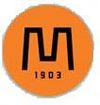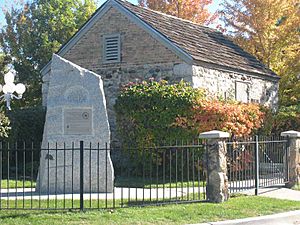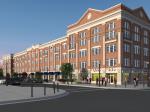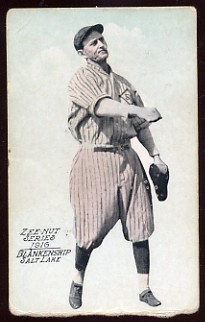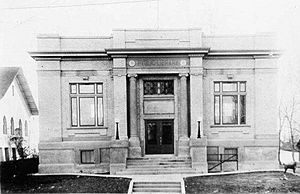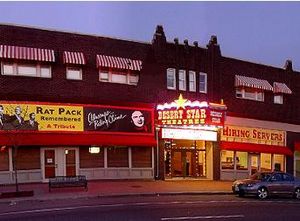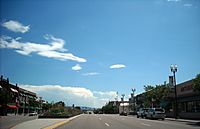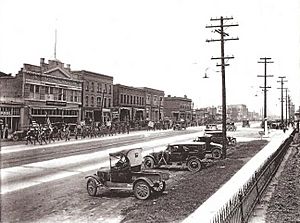Murray, Utah facts for kids
Quick facts for kids
Murray, Utah
|
||
|---|---|---|
|
City
|
||
|
||

Location in Salt Lake County and the state of Utah.
|
||
| Country | United States | |
| State | ||
| County | Salt Lake | |
| Settled | 1848 | |
| Incorporated | January 3, 1903 | |
| Named for | Eli Houston Murray | |
| Government | ||
| • Type | Mayor-Council | |
| Area | ||
| • Total | 12.32 sq mi (31.92 km2) | |
| • Land | 12.32 sq mi (31.91 km2) | |
| • Water | 0.00 sq mi (0.01 km2) | |
| Elevation | 4,301 ft (1,311 m) | |
| Population
(2020)
|
||
| • Total | 50,637 | |
| • Density | 4,110.15/sq mi (1,532.75/km2) | |
| Time zone | UTC−7 (MST) | |
| • Summer (DST) | UTC−6 (MDT) | |
| ZIP codes |
84107, 84117, 84121, 84123
|
|
| Area code(s) | 385, 801 | |
| FIPS code | 49-53230 | |
| GNIS feature ID | 1443742 | |
| Demonym | Murrayite | |
Murray is a city in Utah, located in the middle of the Salt Lake Valley. It's part of the Wasatch Front area. The city is named after Eli Houston Murray, who was a governor of the Utah Territory. In 2020, about 50,637 people lived there.
Murray is surrounded by other cities like Taylorsville, Holladay, and West Jordan, Utah. It used to have many factories, but now its main businesses are healthcare, stores, and professional services. Murray is often called the Hub of Salt Lake County because of its central spot.
What makes Murray special is that it runs many of its own services. This includes its own police, fire, power, water, library, and parks departments. It even has its own school district! Even with all these services, Murray has one of the lowest city tax rates in Utah.
Each year, thousands of people visit Murray City Park for sports and to enjoy its natural areas. Murray is also home to the Intermountain Medical Center, which is the city's biggest employer. Since 1977, Murray has been recognized as a Tree City USA for its efforts in caring for trees.
Contents
History of Murray
Early Days Before Settlement
Before settlers arrived, the area where Murray is now was a natural home for Native American tribes. These included the Paiute, Shoshone, and Bannock tribes. They would camp along the local creeks and streams as they traveled. Signs of their camps have been found near the Jordan River, especially around Willow Pond Park.
One important camping spot was at the "big bend" of the Jordan River. Here, the Goshute Native Americans from Skull Valley would set up camp every spring. They were on their way to hunt near the Bear River. When they returned in the fall, they would stay for a week and trade with the early white settlers. They often traded items like buffalo robes, deer skins, and dried meat.
A New Settlement Begins
Early settlers, often called pioneers, arrived in the Salt Lake Valley in 1847. A group known as the Mississippi Saints came a year later in 1848. They started to build homes in the southern part of the valley. This area was known by different names, such as Mississippi Ward or Cottonwood. By the 1860s, at least 20 families lived in the South Cottonwood area.
When the first pioneer families settled in 1848, they chose lands near the Little Cottonwood Creek and Big Cottonwood Creek. These areas had plenty of grass for their animals. It was also easy to use the water from the streams to grow their crops. The higher lands were covered with sagebrush and were settled later.
There was a high piece of land surrounded by lower ground, north of what is now Vine Street. Before and after the pioneers arrived, Ute Native Americans used this spot as a camping ground. This was because they could find water and grass nearby, and they could see anyone approaching from far away. This area is now the Murray City Cemetery. Early settlers agreed that this land should belong to the community.
In 1853, workers started hauling large granite rocks from Little Cottonwood Canyon. These rocks were for building the Salt Lake Temple. A dirt road was made along what is now Vine Street. The east side of this road became a rest stop for the workers. The first building outside of Salt Lake City built for both religious and school use was on Gordon Lane. A monument from the Sons of Utah Pioneers marks this important spot.
The Pony Express also traveled through central Murray, along what is now State Street. A Pony Express station called "Travelers' Rest" was located near present-day 6200 State Street. It was a simple place with a stable and a small bunk house. The Sons of Utah Pioneers put up a monument in Midvale to remember this station.
The area stayed mostly farmland until 1869. That year, valuable metal was found in Park City, Utah and Little Cottonwood Canyon. Because Murray was centrally located and had access to the railroad, the first smelter (a factory that melts metal) was built there in 1870. For the next 30 years, Murray became home to some of the biggest smelters in the region.
The first official post office opened in 1870 as the South Cottonwood Post Office. The area grew as the railroad arrived, smelters expanded, and new roads and trolley lines were built. A business area also started to grow along these transportation routes.
The city got its current name, Murray, from the post office. The post office officially changed its name from South Cottonwood to Murray in 1883. This was in honor of Eli Houston Murray, who was the territorial governor of Utah from 1880 to 1886.
After some trouble caused by smelter workers, a local newspaper editor suggested that the settlement become an official city. A group worked to make this happen, and an election was held on November 18, 1902. The people who wanted the city to be official won. C.L. Miller was elected as the first Mayor. Murray officially became a city on January 3, 1903.
Murray as a Center for Industry
Murray's central location in the Salt Lake Valley made it a great place for factories. The building of the Woodhill Brothers' smelter in 1869 started Murray's industrial history. In 1870, Murray produced the first silver bars melted in Utah. Later, the American Smelting & Refining Company (ASARCO) was formed in 1899. The smelters were very important to the local economy until the ASARCO lead smelter closed in 1949.
Other businesses also grew with the smelter industry. Murray's industries included a water plant, a lighting system, a canning factory, flour mills, and brickyards. Many workers at the smelters were immigrants from Scandinavian countries. They often spoke little English and settled in the area west of State Street. They even had separate church services in the Swedish language.
Murray's industries faced big problems during the Great Depression in the 1930s. The smelters started closing in 1931, and most major factories were gone by 1940. Murray used federal projects to help with the economic loss. In 2000, the famous ASARCO Smelters were taken down. Intermountain Healthcare bought the land for its Intermountain Medical Center. The smelters are still remembered in Murray City's logos.
From World War II to Today
After the big factories closed before World War II, and with the new freeway system in the 1950s, Murray became a major shopping area. This was because of its central location. State Street is now home to many car dealerships. Larry H. Miller bought his first car dealership here in 1979.
Fashion Place Mall was built in the 1970s. It's now a big shopping center that was updated and expanded in the early 2000s.
Cottonwood Hospital opened in the 1960s and was highly recognized. It was replaced by Intermountain Medical Center (IMC) in 2007. IMC also led to the creation of The Orthopedic Specialty Hospital (TOSH) in the 1990s.
In the 1990s, the Utah Transit Authority (UTA) built its TRAX light-rail line. Three stations were built in Murray along the main route, which is the Blue Line. The Fireclay Housing Project became famous for building homes around the Murray North station. Murray’s Fashion Place West station is where the Red Line light-rail line connects. In 2012, the FrontRunner commuter rail service was extended to the Murray Central station.
In the mid-2000s, people from an area called Cottonwood West asked to become part of Murray. This added about 17,000 people to Murray's population.
Geography of Murray
Land and Features
Murray is located in the middle of the Salt Lake Valley. The city covers about 9.6 square miles (24.9 square kilometers) of land. It has a mix of businesses, homes, and industrial areas. The land generally slopes gently from the nearby Wasatch Mountains towards the Jordan River.
Murray's average height above sea level is about 1300 meters (4300 feet). The highest parts are near the border of Cottonwood Heights. The lowest parts are along the Jordan River.
The Wasatch Fault is a major fault line located about three miles east of Murray, near Holladay. Because of this, there is a risk of liquefaction in Murray during an earthquake. This is when soil acts like a liquid. The city has rules in place to help protect buildings from this risk.
Waterways
The Jordan River is the biggest water feature in Murray. It flows along the western edge of the city and eventually reaches the Great Salt Lake. Murray has a trail and green area along the river that runs through the whole city.
Big Cottonwood Creek and Little Cottonwood Creek also flow into the Jordan River within Murray's borders. These creeks run between properties, along streets, and through parks. There are also important wetland areas next to the river and these creeks.
Murray has only a few small lakes. Willow Pond and Turner Pond are the largest natural lakes. Willow Pond is the only one open to the public for fishing. There are also some man-made lakes on the Lynn Pett Murray Parkway and Mick Riley Golf Courses. Other small lakes are found in Murray’s wetland areas.
Weather in Murray
| Climate data for Murray, Utah | |||||||||||||
|---|---|---|---|---|---|---|---|---|---|---|---|---|---|
| Month | Jan | Feb | Mar | Apr | May | Jun | Jul | Aug | Sep | Oct | Nov | Dec | Year |
| Record high °F (°C) | 61 (16) |
67 (19) |
76 (24) |
86 (30) |
93 (34) |
100 (38) |
101 (38) |
102 (39) |
96 (36) |
86 (30) |
75 (24) |
68 (20) |
102 (39) |
| Mean daily maximum °F (°C) | 39 (4) |
44 (7) |
53 (12) |
61 (16) |
70 (21) |
82 (28) |
89 (32) |
88 (31) |
78 (26) |
65 (18) |
50 (10) |
40 (4) |
63 (17) |
| Mean daily minimum °F (°C) | 25 (−4) |
30 (−1) |
37 (3) |
43 (6) |
51 (11) |
60 (16) |
67 (19) |
66 (19) |
57 (14) |
46 (8) |
35 (2) |
27 (−3) |
45 (8) |
| Record low °F (°C) | 8 (−13) |
−3 (−19) |
16 (−9) |
26 (−3) |
30 (−1) |
39 (4) |
50 (10) |
45 (7) |
37 (3) |
23 (−5) |
12 (−11) |
−6 (−21) |
−6 (−21) |
| Average precipitation inches (mm) | 1.58 (40) |
1.63 (41) |
2.02 (51) |
2.18 (55) |
2.31 (59) |
0.84 (21) |
0.71 (18) |
0.64 (16) |
1.24 (31) |
1.69 (43) |
1.65 (42) |
1.26 (32) |
15.74 (400) |
Education in Murray
Schools for Kids and Teens
The Murray City School District started on January 1, 1906. It has ten schools: seven elementary schools, two middle schools (Riverview and Hillcrest), and one high school (Murray High School). Murray High School is a 4-A school in Utah's sports leagues. It was even used as a filming location for the High School Musical movie series by Walt Disney Company.
The Granite School District also runs two schools within Murray's boundaries: Cottonwood High School and Woodstock Elementary School.
Colleges and Higher Learning
Several private colleges have campuses in Murray. These include University of Phoenix, Stevens-Henager College, and Eagle Gate College.
Parks and Fun Activities
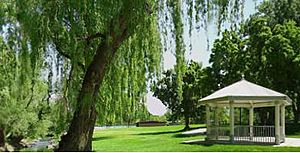
Murray used federal projects during the Great Depression to build its park system. The city worked to improve its 22-acre Murray City Park and buy more land for fairgrounds. By 1939, Murray was the location for the yearly Salt Lake County Fair. Later, the fair moved, and the old fair buildings were replaced by the Park Center. This community recreation facility has indoor swimming pools, an indoor track, exercise rooms, and a gym.
Murray Park's Ken Price Ball Park has hosted the Babe Ruth League World Series for 13-year-olds in 2009 and 14-year-olds in 2012. Next to Murray Park is the Salt Lake County Ice Center, which was used for practice during the 2002 Olympic Winter Games.
Murray also has many neighborhood parks and the large Jordan River Parkway. This park system has natural trails along the Jordan River for walking, horseback riding, and picnics. The trails connect several city parks like Winchester, Walden Park, Germania Park, and Arrowhead. The parkway also has The Kennecott Nature Center, which is an environmental education center used by schools.
Wheeler Historic Farm is located in Murray. Salt Lake County runs this farm, which shows what a dairy farm was like around the year 1900. It teaches visitors about Utah's farming history and rural life from 1890 to 1920.
Parks and Recreation Spots in Murray
Salt Lake County Facilities
- Mick Riley Golf Course: Has two courses, an Executive and a Par 3 course.
- Salt Lake County Ice Center: Offers ice skating and hockey.
- Wheeler Historic Farm: A historical park and natural area.
Murray City Facilities
- Park Center: Features an indoor pool, basketball courts, weight room, and track.
- Murray Aquatics Center: An outdoor swimming pool.
- L. Clark Cushing Senior Recreation Center: A recreation center for senior citizens.
- Lynn Pett Murray Parkway Golf Course: An 18-hole golf course.
- Jordan River Parkway: Natural trails for walking, biking, and horseback riding.
- Murray City Park: Includes baseball and softball stadiums, soccer fields, a rugby field, an arboretum, and an amphitheater.
- Arrowhead Park: A picnic area and trail access.
- Germania Park: Has outdoor basketball, soccer, and a playground.
- Grant Park: A baseball complex and playgrounds.
- Hidden Village Park: Offers tennis, soccer, and a playground.
- Southwood Park: Has tennis courts and a playground.
- Walden Park: Features a canoe launch and a playground.
- Willow Pond Park: Good for fishing, baseball, soccer, and playgrounds.
- Winchester Park: A canoe launch, natural area, and playground.
- Woodstock Meadows Park: A natural area with a pavilion and playground.
- Riverview Park: Includes tennis courts, shuffleboard, horseshoe pits, and a baseball complex.
Sports in Murray
Ice Skating and Hockey
During the 2002 Winter Olympics in Salt Lake City, the Salt Lake County Ice Center was used for practice. It hosted a women's hockey game between Germany and Kazakhstan. The facility offers figure skating lessons and hosts an adult hockey league. Youth and beginner hockey lessons are also available.
Rugby
The Murray Park Rugby Stadium has hosted USA Rugby's national high school championships. The Highland Rugby club, a very successful high school rugby team, is based here. Many semi-professional, adult, college, and high school rugby clubs use this field.
In June 2012, this stadium hosted the 2012 IRB Junior World Rugby Trophy.
Baseball
In 1914, Murray had its own professional baseball team called the Murray Infants. The team was managed by Cliff Blankenship, a former player for the Cincinnati Reds and Washington Senators. Famous players included Ike Caveney and Mickey Shader. The team stopped playing in 1914 when its league ended.
In August 2009, Murray hosted its first 13-Year-Old Babe Ruth League World Series. All games were played at the Ken Price Ball Park, which seats 3000 people. This park is also the home field for the Murray High School baseball team. Adult, high school, and youth leagues use this facility. Murray also hosted the 14-Year-Old Babe Ruth League World Series in 2012.
Basketball
When the Utah Jazz basketball team first moved to Utah in 1979, the Sports Mall fitness center was used as a practice facility for visiting teams. Famous players like Larry Bird and Magic Johnson practiced there. Later, the Jazz built their own practice center.
Utah Jazz players also hold basketball clinics and camps for young people at the Murray Park Center. Murray's adult and youth basketball leagues are run by the Murray City Parks and Recreation department.
Soccer
Murray was one of the top choices to be the home of the Real Salt Lake soccer team, but the stadium was built in Sandy, Utah. The Murray Parks and Recreation department runs adult and youth soccer leagues that play on the city's many soccer fields. There is also a small soccer stadium in Willow Pond Park. The US Youth Soccer Association holds games there.
Golf
The Murray Parkway Golf Course is considered one of the top 25 golf courses in Utah. It has hosted events for the Utah State Amateur Championship. Mick Riley Golf Course has also hosted Utah State Amateur events.
Boxing
Murray used to host many championship boxing matches in the early 1900s. A famous event was boxing legend Jack Dempsey's only knockout defeat. This happened at the Murray Fire Hall on February 13, 1917, when Fireman Jim Flynn knocked him out in the first round. Many people wondered if Dempsey had let Flynn win, but witnesses said he was down for a long time. A year before, Dempsey had beaten another boxer, Young Hector, at the same place.
Murray also hosted the 1913 welterweight boxing tournament for the western United States. Ernest "Cyclone" Wright won the championship there. He was also a member of Murray's first volunteer fire department.
Murray City Library
The Murray City Library opened on January 6, 1911. It started as one of the Carnegie libraries, which were built with money from Andrew Carnegie. In 1965, Murray opened another small library on Valley Drive. In 1992, the city combined its two libraries into a new, larger center on 5300 South. This new library had more books, study areas, and meeting rooms. It was updated again in 2008 to add more public computers and Wi-Fi. The old Carnegie library on Vine Street was taken down in 2020 to make way for new buildings.
Murray's library is separate from the Salt Lake County and Salt Lake City library systems. However, you can borrow books from any of these libraries if you have a card from one.
The Murray City Library offers many activities for all ages. These include book clubs, story times for younger children, chess clubs, and after-school programs for kids and teenagers. The library has books, DVDs, CDs, audiobooks, tablets, Wi-Fi hotspots, and even a telescope that you can check out. Online, you can download books, audiobooks, magazines, music, and movies. In 2023, the library teamed up with Murray City Parks and Recreation to create the Tale Trail. This is an outdoor reading experience for children and their families.
Arts and Culture in Murray
Murray is home to several groups that perform plays and music. The Desert Star Playhouse is located in the historic Iris Theatre. It is known for its funny community plays and melodramas. The historic Murray Theatre hosts many musical acts throughout the year. It has also shown films for the Slamdance Film Festival. The city also has the Murray Park Amphitheatre, which puts on plays outdoors in Murray Park during the summer.
The Murray Symphony Orchestra (MSO) is a community orchestra with both professional and amateur musicians. The MSO is made up of volunteers and gets money from Murray and Salt Lake County. The MSO also has jazz and string groups.
The Ballet Centre in Murray offers ballet performances and training for both children and adults. The Murray Arts Centre teaches ballroom dancing and other modern dance styles every day. It often has live big band and jazz music.
The Murray City Cultural Arts program started in 1992. This program, along with the Arts Advisory Board, creates cultural activities all year long. These include art projects in schools, workshops, camps, musicals, and art shows. More than 5,000 young people and adults take part each year. Summer and winter performance seasons have been running successfully since 1990. The "Murray Arts in the Park" events entertain over 13,000 people every summer.
Historic Buildings in Murray
Murray has several buildings and areas that are listed on the National Park Service's National Historic Register. This means they are important historical sites. Some of these include:
- Murray Downtown Historic District
- Murray Downtown Residential Historic District
- Wheeler Farm
- Murray Theater
- Desert Star Theater
- John P. Cahoon House (also known as Murray Mansion)
- Murray LDS Second Ward Meetinghouse
- Warenski-Duvall Commercial Building and Apartments
People of Murray
| Historical population | |||
|---|---|---|---|
| Census | Pop. | %± | |
| 1900 | 3,302 | — | |
| 1910 | 4,057 | 22.9% | |
| 1920 | 4,584 | 13.0% | |
| 1930 | 5,172 | 12.8% | |
| 1940 | 5,740 | 11.0% | |
| 1950 | 9,006 | 56.9% | |
| 1960 | 16,806 | 86.6% | |
| 1970 | 21,206 | 26.2% | |
| 1980 | 25,750 | 21.4% | |
| 1990 | 31,282 | 21.5% | |
| 2000 | 34,024 | 8.8% | |
| 2010 | 46,746 | 37.4% | |
| 2020 | 50,637 | 8.3% | |
| U.S. Decennial Census | |||
In 2020, there were 50,637 people living in Murray. Most residents (78.7%) were White. Other groups included Black (2.3%), Native American (1%), Asian (3.4%), and Pacific Islander (0.8%). About 13.1% of the population identified as Hispanic or Latino.
Getting Around Murray
Roads and Freeways
In southern Murray, there's a big interchange where Interstate 15 meets Interstate 215. Interstate 15 is a ten-lane freeway that runs north and south through the middle of Murray. Interstate 215 is an eight-lane freeway that generally follows the southern edge of the city.
Interstate 15 has two exits within Murray: at 4500 South and 5300 South. Interstate 215 has exits at State Street and Union Park Boulevard. State Street runs through central Murray, passing through the historic downtown area and major shopping centers. Van Winkle Expressway is a four-lane road that forms Murray's eastern border. 4500 South crosses the northern part of Murray and goes across the entire Salt Lake Valley.
Trains and Railways
Historically, trains were very important for Murray's growth. In 1870, a railroad line called the Utah Southern was extended through Murray. Later, the Denver and Rio Grande Western Railroad built a depot in Murray. The Utah Northern Railway also had a key stop here in the late 1800s. This connected mining areas like Park City and Bingham to Murray's factories.
In the early 1900s, downtown Murray could be reached by trolley car. The trolley ran along State Street from downtown Salt Lake City to Murray.
Public Transportation
Murray is served by the Utah Transit Authority (UTA) bus system. Two lines of UTA's TRAX light rail serve Murray. The Blue Line connects Murray to Downtown Salt Lake City and Draper. The Red Line connects to the University of Utah and the Daybreak Community in South Jordan. Both lines connect further north with the Green Line, which goes to West Valley City and the Salt Lake City International Airport.
Murray's TRAX system has three stations: Murray North station, Murray Central station, and Fashion Place West station. Murray Central station is special because it's the only station outside of Salt Lake City where both FrontRunner commuter rail and TRAX connect. FrontRunner service was extended to Murray in December 2012.
City Services
Electric power came to Murray in 1905 with the Progress Electric Company. They set up wires to light over a hundred street lights and a few buildings. People and businesses wanted more electricity than the company could provide. So, on July 9, 1912, the city decided to create its own power company. At the same time, it also created its own water and sewage system. Murray gets much of its electricity from natural gas, coal, and water turbines. Murray was also one of the first cities in Utah to get power from methane gas produced in its landfill. This methane can provide up to 13 percent of Murray's electricity needs.
Murray Public Services manages the city's water, sewer, and garbage and recycling programs. Some parts of the city also get water from the Salt Lake Valley Water Conservancy District and Jordan Valley Water Conservancy District.
Sister Cities
| Taiwan | Chiayi | Chiayi County |
Famous People from Murray
- Gary Andersen: A football coach at Utah State University.
- Jack Anderson: A Pulitzer Prize winner who started writing for the Murray Eagle.
- David Archuleta: The runner-up on American Idol Season 7.
- Shawn Bradley: A former basketball player for Brigham Young University and the NBA.
- Deondra Brown: A member of The 5 Browns classical piano group.
- Nathaniel Coleman: An Olympic silver-medalist in sport climbing in 2020.
- Kevin Curtis: A former National Football League player.
- Bruce Hardy: A former Miami Dolphins football player and Arena Football coach.
- Ken Jennings: Famous for his 72 wins and over $2.5 million on Jeopardy!.
- Britton Johnsen: An NBA basketball player.
- Chris Mazdzer: An Olympic Luge silver medalist.
- Jerold Ottley: A music director who led the Mormon Tabernacle Choir from 1974 to 1999.
- Kim Peek: The inspiration for the character Raymond Babbitt in the movie Rain Man.
- Golden Richards: A former wide receiver for the Dallas Cowboys.
- Dan Snarr: Served as mayor of Murray four times.
Murray in the Media
- American Idol showed Murray and Murray High School during David Archuleta's homecoming in Season 7.
- Tiffany filmed parts of her music video "I Think We're Alone Now" at Fashion Place Mall and Murray Park.
- Walt Disney Productions filmed four movies at Murray High School: Take Down (1978), Read It and Weep (2006), the auditorium scene of High School Musical (2006), and Minutemen (2008). Disney also used the school for the 2008 reality TV show High School Musical: Get in the Picture.
- The Real Housewives of Salt Lake City featured Heather Gay's "Beauty Lab + Laser" clinic in Murray.
Images for kids
See also
 In Spanish: Murray (Utah) para niños
In Spanish: Murray (Utah) para niños


